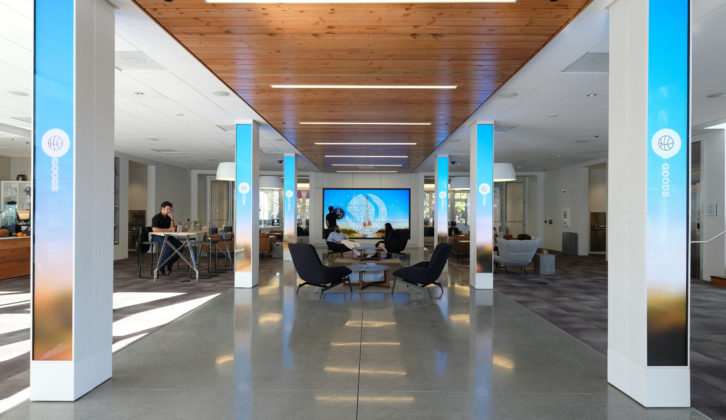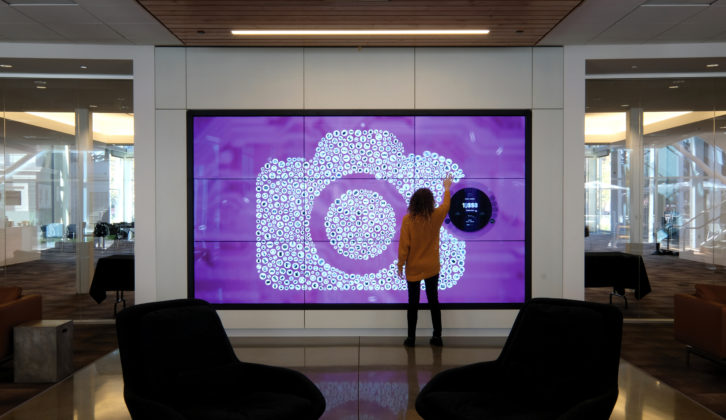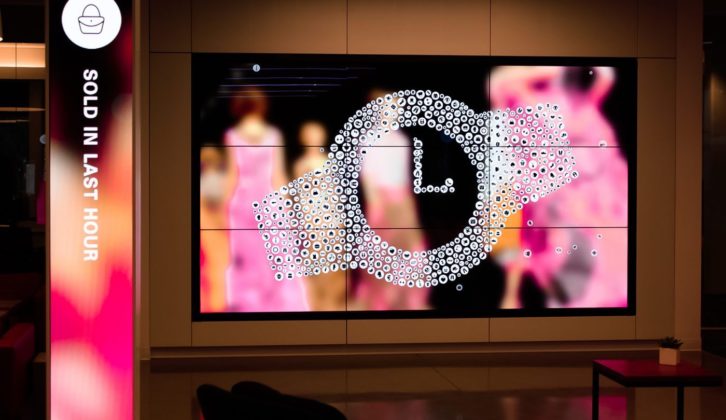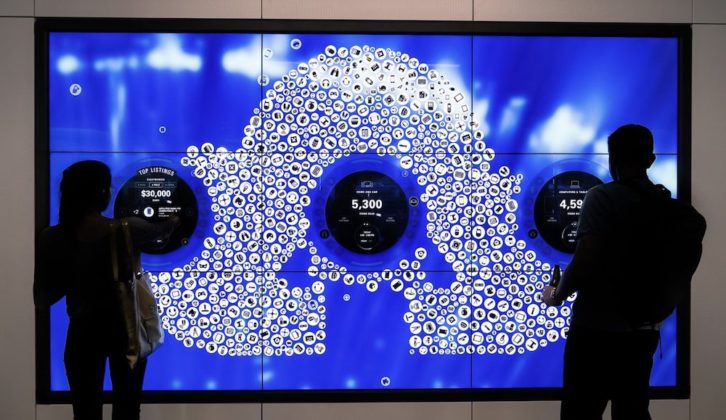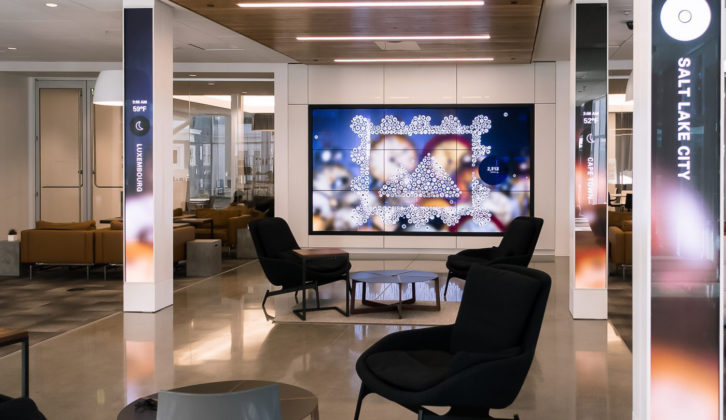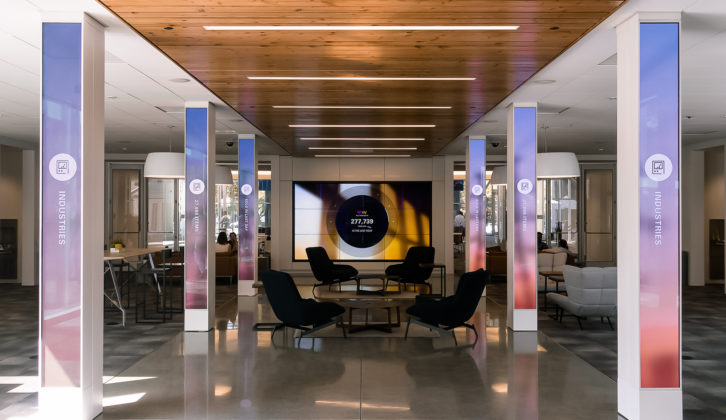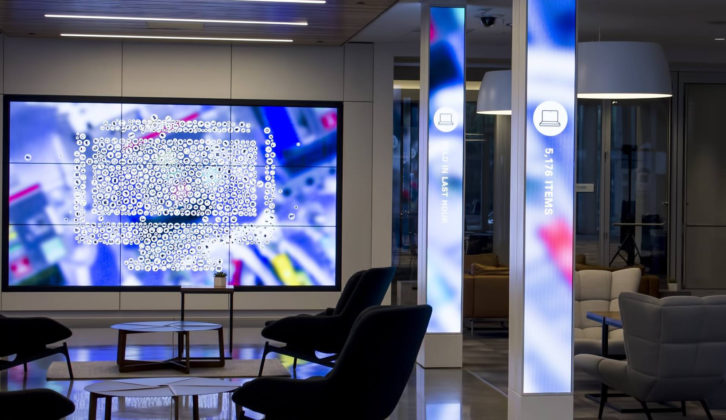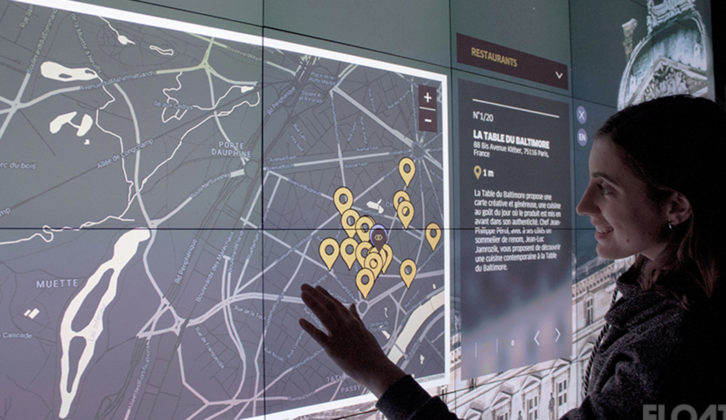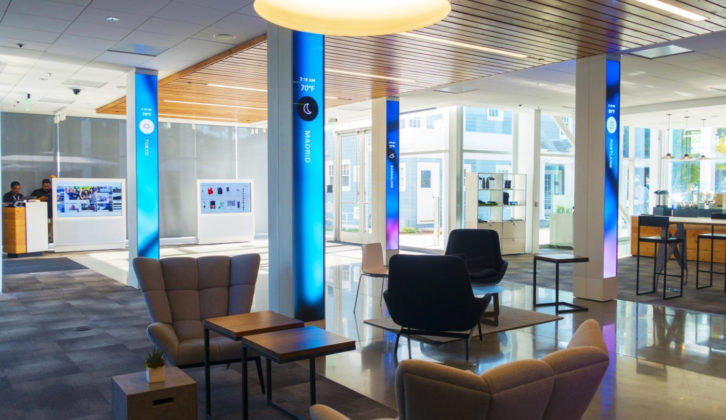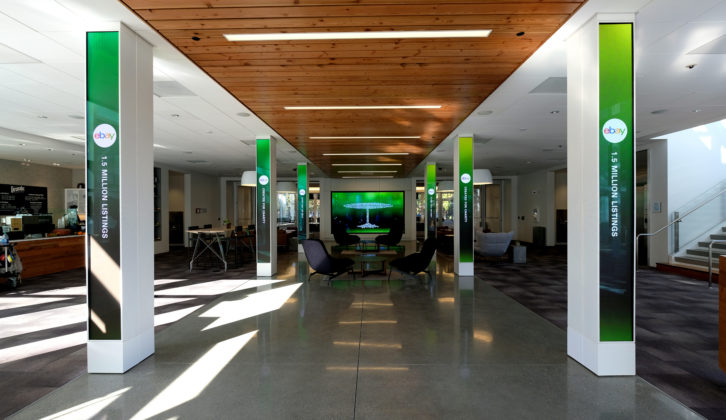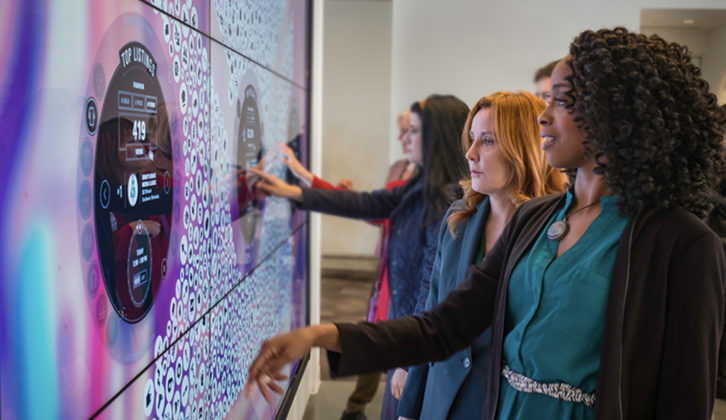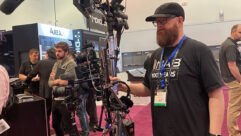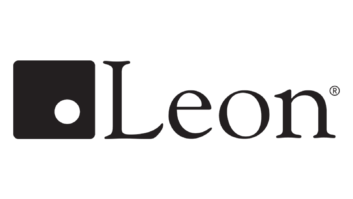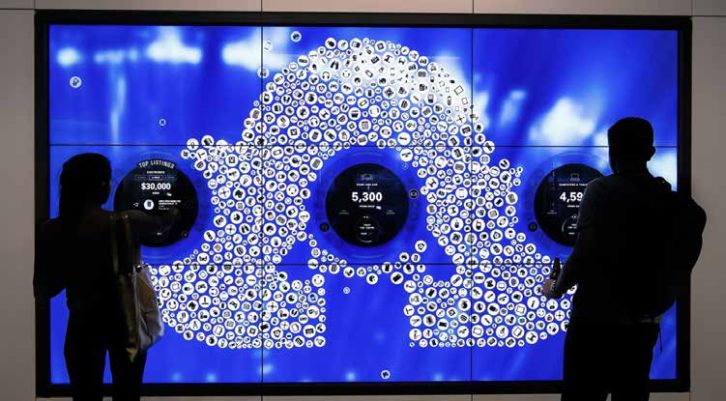

eBay’s new Main Street is the entry to their campus. ESI Design designed the entire building, interior and interactive experience, as we’ll hear from Senior Design and AV technologist Emily Webster. Float4 executed the creative concept for engaging eBay workers and visitors, while Diversified provided installation.
WATCH THE ESI DESIGN TOUR
SEE THE INSIDE
SVC: First let’s start with ESI’s collaborators: Adam Lopez of Diversified is here with Alex Simionescu and Sevan Dalkien of Float4 to get an idea of the technical challenges. I can see how not just the installation, but the programming and the application itself were a very tall order on this project, so it had to be a collaboration on many fronts.
Adam: Yeah, the eBay installation was extremely coordinated among trades, meaning the architect, structural engineer, and building GC. The main iconic Leyard LED display in the Main Street Hall spans 45 feet wide by 12 feet high in a five-screen, 2.5 millimeter configuration. What was amazing is this display floats in front of a glass wall with zero mullion around it. The LED goes right to the edge. Our engineers worked really closely with the architect and engineers to build a steel, load-bearing structure that suspended the thing four feet away from the wall and 10 feet in elevation above the stage. And the outcome was amazing: the LED floating in front of glass with redwood trees behind it. There were also the 1.6 millimeter LED columns and we took a lot of care in designing and mocking them up. We actually got one of the steel beams from the general contractor into our shop and we physically built the LED columns. They are treated with glass on the front for a retail-type environment. We have perforated steel housing that goes around the sides to create the air flow that we need. And then this was all custom fabricated with an aircraft cable system that actually lowers LEDs so we can provide service to that after installation. The physical installation was very custom and quite exciting the way it turned out.

This was a very high profile project with a lot of time and money invested in it: Alex at Float4, what did eBay want to accomplish with the huge new Main Street display?
Alex: I think first and foremost is: make a statement. eBay is a company that is considered one of the pioneers of online transactions. So if you look at the space and you look at the content that’s displayed on there, it’s very, very much data driven and it’s something that is primarily used to show the quantity of transactions that go through the eBay website. Such as how many people at any given moment are able to exchange their goods thanks to the services that they have. Actually, one of the things that I really like about the space is it has some of the first items that were sold on eBay. Honestly, I think one of them was a laser pointer and they got it back from the person who ended up having it so many years after. But also from an architectural standpoint I think what really sets it apart is how the digital media is integrated—and I think Adam described it really, really well—within the architectural elements that distinguish the space. This is no longer about a screen that is hung to a wall. It’s about digital media being applied as a material to the space and then being dynamic and, in this case, very, very interactive. So that’s how I would summarize it.
Adam, after everything was connected, the whole operation was hooked up. What was done to add the control programming to this and really bring it to life?
Adam: The entire system is built around an AMX control system. This is an eBay standard so they wanted to apply standards to their audio/visual environment. The AMX control system then ties into the CMS servers that are generating real-time data that are coming from the Float4 RealMotion software. We have a series of sensors, cameras around LED columns and the multi-touch Planar video walls, which interact with the lobby’s environment. So all the data that Float4 is processing is turned into generative content. That keeps that content fresh within the entire lobby and in their ambient modes, as they call them, it’s not static and the content is very engaging.
And how is it operated by the viewer? It looks like you can really get into this and it must be as fun as it is informative.
Alex: Absolutely. I think that’s one of the things—and you notice it a little bit on the video, a lot more when you’re there in person— but one of the approaches that we use in these types of environments is to layer different types of interactions. So in this space, for example, you have a motion-sensing device that will detect the user’s silhouettes before they’re within arm’s length of the wall. So that’s the first thing that we use to kind of break the ice with an interactive experience. It’s not something that’s complicated. There are no manuals needed. When people aren’t necessarily aware that it’s an interactive experience, it’s a great way to ease them into that experience. The second phase is through touch, and as Adam mentioned the Planar video wall that supports multi-touch capability, so more than one person can interact with it. And that also goes for the motion sensing part. So on that end, once you’re within arm’s reach, you’re able to touch one of the many articles that’s generated by our system and then you have an interface that appears that allows you to navigate through different categories of products and see the quantity of products that were sold in that specific category at a given time or over a given period. So it’s a progressive experience. It’s something that starts with something more playful, but then becomes a lot more informational.

I understand that the RealMotion platform has three main parts. Sevan, can you tell us about those?
Sevan: This was a complex project because it had to be a collaborative effort among many companies and tons of people had to work with this. I think one of the challenges with this project was to create a visually-compelling experience that was fun, and that people would quickly understand how to interact with—in a way that was also respecting and accurate to eBay’s vision. So, how to translate eBay’s vision into an engaging digital experience? In order to accomplish that you need to have a platform, which is in our case a hardware and software platform, which really has been designed from the ground up. We’ve been working on this solution for more than five years now from our beginning background. And the idea is to provide the necessary infrastructure to be able to generate content in real time. So as opposed to simple and more traditional video playback, the platform really allows data or visuals to be played in a more dynamic way where things will react and adapt to the source of inputs. As Alex and Adam mentioned, these inputs can be sensors, cameras, touch screens, or in our case also live data that was coming straight from eBay’s database. So we were able to adapt the content live as users all around the world were actually engaging in transactions on eBay’s website. We wanted to visualize those transactions in a much more fun and engaging way through a particle system that would mimic the various categories of eBay’s products so people would be able to click on those and dive in deeper into the whole world of eBay.
Our product is composed of three main elements. The first is the hardware. That’s the media server that is usually powering the displays, communicating with the various sensors and eBay’s database of course.
The second part is the software that really allowed the creative designers to program or script all the behaviors of the particle system, the images of the background—all that has been customized and thought up by the ESI team up in New York. And the third aspect is an operational aspect. The thing is these projects need to run for as long as they can. They’re meant to be on screens for 24/7, so the system needs to be extremely reliable and stable in that sense. So for us it was important to offer a third element in our product, which is the real admin tool which really allows our clients, and Diversified, to actually monitor the project, see that everything is going on correctly in accordance to specifications for the hardware and software and all the communicational aspects. So these three elements ensure that a project such as the one at eBay was not only engaging on the creative side, but also maintainable from an operational aspect to the 24/7 experience.
Adam, your people had to make sure the nuts and bolts of this got done right. What kind of a time window were you working with on with all this?
Adam: Really from core, shell and steel to the first day of business was about one year. But I do know that ESI and eBay were working on that well before that—probably a year before that. So it was probably about a two-year process from concept to completion.
Now let’s hear from ESI Design Senior Designer and AV technologist Emily Webster. ESI designed the entire building, the space, and the content. First, tell us about what ESI Design does, and how did you get into this project?
Emily: Well, thanks for having me on, Bennett. ESI Design is an experience design firm. We’ve been working in the industry for over 40 years, and what we like to do is to transform places into experiences. So we have worked with a number of different brands and organizations and cultural institutions, and we really try to fundamentally change how people connect with each other. So we’re often going in to look at a different brand or a different organization and ask, what’s really interesting about that brand? What can we lift up and elevate and show to the rest of the world that people will really engage with? So we’re trying to figure out what’s the most interesting story that a certain brand or organization or institution wants to tell about themselves.
Well, you certainly had your work cut out for you on eBay because that company is all about connecting. Not only connecting with clients but the communication among the eBay people. How does your design reflect that culture of the company?
I think we were ultimately trying to create a place that was for the eBay community. When we came to the project, eBay had just recently started the process of separating themselves from the PayPal company. So until 2015 eBay and PayPal were sister companies, and that meant eBay could go to PayPal’s campus and use their facilities and their resources to have meetings that brought together thousands of people from their companies. So it was really a way for them to bring their community together and have discussions and meetings and events. When they separated from PayPal they no longer had access to a space like that, so they were really needing somewhere that their community could come together, and at the same time they wanted to create a new front door for themselves, so to speak—a grand way to welcome visitors and potential clients and vendors and partners. And to do so in a way that was really dynamic and expressed the fact that they are a technology company and working to innovate on a daily basis. Before Main Street, they didn’t really have a space that could be both a showcase and a practical space, so it really is reflecting their culture because there’s a lot going on at eBay. There are buyers and sellers and auctions and bidders and charitable events happening and hack-a-thons, but it all sort of rides on this backbone of technology. So they wanted a very dynamic greeting place/ meeting space/community space that could really bring everybody together in a really compelling way.

Well, once you’ve seen this place you’ll never forget it.
Yeah. I mean, we hope so. And we really designed it to be something that was impressive and something that you could come in and say: this is eBay. But then also really use that space very practically to have meetings. They have thousand-person meetings a couple times a month, so it really needed to work for them as a very practical kind of meeting and gathering space.
And when you walk in there, the main attraction is going to be that huge central interactive display. It’s gigantic and you know, I’d just love to sit there and watch the effect on people and watch how they use it before I even tried it myself. How did you arrive at the design for that main interactive display?
Well, we knew that we wanted to tell a very up-to-the-minute story about what was happening on the eBay platform. And so the multitouch wall, that big surface, tells the story. It taps into a number of curated data feeds from the eBay website to show data about what’s happening on eBay right now. So you can walk up to the wall and tap on an icon and that icon represents a product that’s sold on eBay. And once you tap on the icon it kind of expands into this dashboard view to talk about number of items sold, top buyers, top sellers, the value of those products, and then you can tap through all the different business verticals that are sold on the eBay platform, so home and garden, electronics, fashion. It really tells that product story. It helps to tell the story about the speed at which products are being sold, the value of the products being sold, and really just tries to express this idea that there’s a lot going on and there’s a lot of opportunity happening on the eBay platform. It’s a lot of diversity of products and buyers and sellers, and it’s really also stories the people who are using the platform. So we came to that after having a lot of discussions with many different stakeholders at eBay and really talking with them and just figuring out okay, what do you guys think is the most interesting? What is the story that you think that we should be exploring and researching and then trying to lift that up to a place where it could be interesting to an employee, because the employees walk through the space every single day. So it needed to be interesting to them over time, but also be sort of digestible and high-level enough that a person, just a random visitor who might be coming in to buy a piece of eBay swag from the store, could learn about eBay as well. So it had to be for both the public and the employee.
You’ve also got some columns out front with their own displays. What do you show on those?
Those are double-sided LED columns. So there are six of them and they are really kind of quick snapshots into the life at eBay. We knew people were going to be coming in through this threshold and walking through there kind of quickly, so we didn’t want that information to be too heavy, take too long to read. It’s really kind of tidbits about what’s going on. And so there are various moments taking place on those columns. There’s a global moment that talks about the number of products sold globally, so two million handbags sold in the last 24 hours or whatever. Then there’s also a product moment that relates to that big multi-touch wall interactive that we were just talking about. Then there’s also a moment that talks about their charitable efforts. There’s a moment that talks about the weather in every single one of eBay’s offices around the world that kind of helps talk about their global impact and their reach. And then there’s also a special message. One of the big ideas for Main Street was that it needed to be very flexible so that it could morph into an appropriate space for another event, whatever the event was that day. And so we wanted to make sure that the content you could put on those columns was editable so if the mayor was coming in you could quickly go in that day and write a message to be really specific to the event happening that day. So you can customize the content. Just recently we went back and we added to the media schedule and came up with two other moments; one that’s sort of a product explosion moment. So before we were using icons to tell the story about the products sold. Now if there are two million handbags sold we show images of all those handbags, and that’s images that come directly from the eBay website.
And there’s a logo moment—eBay is going through kind of a rebranding with some of the colors they use in their logo and their brand, so we wanted to help tell that story. And I would think that this building has so much glass in it that company staff can almost just look up from their desks and wave and communicate through sign language.
[Laughs] Yeah, well we really wanted it to be a bright, airy space that people wanted to go to. We didn’t want you to have to go into a kind of dark auditorium. Everybody is stuck inside all day anyway so we wanted to make sure you were getting these kind of beautiful vistas out to the spaces around you and really feeling like it was a refreshing space to enter into and hang out in.

Now, have you had other projects that sort of led you up to this, I mean that you got the ideas from and maybe combined some of them on this one?
You know, eBay was definitely a unique one and every time we work on a project we really do make sure that it’s appropriate for whatever the client is. But we always kind of take the same approach. What is the audience we’re trying to talk to? What is the story we want to tell? And how do we want people to experience that in an immersive way? So it’s a new kind of output. It’s a new idea, but the thinking and the logic that got us to this approach is very much a similar process to what we’ve gone through before. Now this building, it’s an actual building that we designed. We designed everything in the building from the sun shades outside to the software interactive to the data API—it was all designed by ESI. Sometimes we work within a building on an exhibit or whatever, but for this one, the entire building was designed by us.
We’ve talked a lot about how it looks, but I would think that with all of the glass in this building that the acoustics could be something of a challenge.
Yeah, it really, you know, it was a challenge. We’ve used a panelized façade wall and on the interior some of those panels are acoustic panels. And actually we did have to change some of the design. On the inside in the main hall there’s a second level mezzanine that has a glass railing and we wanted it to be straight at first, but after we did the acoustic study we made the mezzanine railing pointed—so it kind of came out at an angle into the room—which helped with sort of bouncing sound around in a different way. It didn’t create a kind of echo chamber. But we definitely study all those things. We’ll work with acousticians when we need to, to make sure that we’re picking the right materials and finishes that won’t create an issue.
What sort of projects does ESI Design have coming up?
We’re doing a lot of really interesting work right now. We are always trying to weave the physical and the digital together, and we can do that for a lot of different industries. We’re working on the Statue of Liberty museum and a number of really immersive exhibits are going into that to help tell the story about how the statue was made and the process that has evolved over the years. We have worked on a number of buildings and continue to collaborate with Beacon Capital Partners, who is a commercial developer and they buy properties all over the United States that we help to refresh with a little makeover to help them become more enticing properties to lease and sell. And we will be very soon unveiling a new video art installation in a shopping mall in Chicago. So a lot of different projects across a lot of different spectrums, but all with this idea of just really an immersive and dynamic space.
